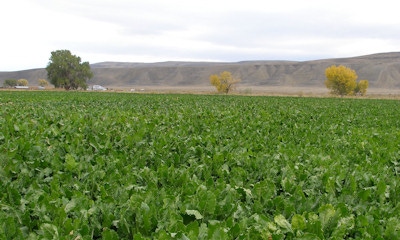October 3, 2016

When it comes to the average farmland real estate value—a measurement of the value of all land and buildings on farms—how does the Cowboy State compare to bordering states, the states in the Western Farmer-Stockman coverage area and the country as a whole?
It’s the lowest, by far.
Following are the 2016 per-acre averages (with 2015 comparisons): Wyoming, $660 (unchanged); Montana, $900 (up 1.1%); Nevada, $1,110 (down 1.8%); Colorado, $1,420 (down 1.4%); Utah, $2,040 (down 0.5%); Oregon, $2,200 (up 3.8%); South Dakota, $2,250 (down 3%); Idaho, $2,500 (up 1.2%); Washington, $2,850 (up 5.6%); Nebraska, $2,950 (down 3.3%); U.S. average, $3,010 (down 0.3%).

SWEET TIMES: Demand for high-quality irrigated cropland is high in Wyoming’s Bighorn Basin. Shown is a typical sugar beet field in the area.
Compared to Wyoming, only one state in the country has a lower value for farmland real estate: New Mexico, $520 (up 2%).
Across Wyoming, the 2016 average value of irrigated cropland was $2,200 per acre, up $10 (or 0.5%) from the previous two years, according to the USDA’s National Agricultural Statistics Service.
The average value of non-irrigated cropland remained unchanged from 2015 at $770 per acre.
Bighorn Basin farmland
There is more demand than supply for quality farmland in north-central Wyoming’s Bighorn Basin, one of the factors contributing to a slight spike in prices, says Landis Benson, president of Hake Realty in Worland.
Rising commodity prices a couple years back helped fuel demand for land, and farms trying to make room for the next generation are trying to purchase or rent what parcels they can.
“A lot of the farmers around here are outstanding operators; they are making a good living and are expanding their operations as much as they can,” Benson says. “We’re seeing a good mix of both owned and rented farmland.”
When farmland does come on the market, it attracts a lot of attention, mostly local farmers.
“Within a day or two, you’ll see a number of producers trying to buy it for expansion,” Benson says. “But since farmers and ranchers are doing pretty well financially, you don’t see a lot of turnover of farm ground or even ranchland in the Bighorn Basin. We have a pretty stable agriculture community so what goes on the market is usually an estate sale or land owned by a retiring couple who do not have family members interested in taking over the operation.”
Producers in the Bighorn Basin raise alfalfa and grass hay, sugarbeets, corn, malting barley, dry beans, cattle and sheep. Alternative crops including sunflower are gaining some traction.
There are two sugarbeet factories in the basin, one in Worland operated by Wyoming Sugar Co. and the other in Lovell by Western Sugar Cooperative.
“The communities around here are very supportive of agriculture. People recognize that it’s a pretty big piece of the economic puzzle,” Benson says.
You May Also Like




